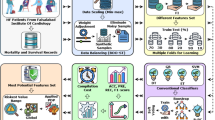Abstract
Relationship between pulmonary embolism and heart failure is presented in this paper. The proposed research is divided into two phases. The first phase includes the establishment of a novel database with the help of a Cleveland’s database for cardiology in order to establish a link between pulmonary embolism and heart failure. The connectivity is based on the relationship between the stroke volume and the pulse pressure (Pp < 25% (ap_hi)). The second phase includes the applicability of machine learning on the novel database. Novel database formed in this work is imbalanced, resulting in the overfitting problem. XGBoost has been used to get rid of overfitting problem. Efficiency has been increased by formulating an ensemble technique by combining extreme learning machines, IB3 tree, logistic regression, and averaged neural network (avNNet) models.
Graphical abstract








Similar content being viewed by others
Abbreviations
- ap_hi :
-
Systolic blood pressure
- ap_lo :
-
Diastolic blood pressure
- Pp :
-
Pulse pressure
- sv :
-
Stroke volume
- pe :
-
Pulmonary embolism
- HF:
-
Heart Failure
References
Chayakrit K, Zhang H (2017) Artificial intelligence in precision cardiovascular medicine in J. of American College of Cardiology
Shrestha S, Sengupta PP (2018) Machine learning for nuclear cardiology: the way forward
Shashikant R, Chetankumar P (2019) Predictive model of cardiac arrest in smokers using machine learning technique based on Heart Rate Variability parameter. In: J. of applied computing and informatics
Alizadehsani R, Habib J, Javad M, Hosseini Mashayekhi H, Boghrati R (2013) A data mining approach for diagnosis of coronary artery disease
Hinton G (2018) Deep learning: a technology with the potential to transform health care. JAMA
Cowger J, McLaughlin V (2018) Acute right ventricular failure in the setting of acute pulmonary embolism or chronic pulmonary hypertension. In: Bentham Science Publication
Ebrahim LA (2018) Cardiac arrest due to pulmonary embolism, Science Direct - Indian Heart Journal
Bizopoulos P, Koutsouris D (2019) Deep learning in cardiology, IEEE Review
Kim J, Kang U, Lee Y (2017) Statistics and deep belief network based cardiovascular risk prediction. In: Healthcare informatics research, vol. 23, no. 3, pp. 169–175
Cano-Espinosa C, Cazorla M, Gonzalez G (2020) Computed aided detection of pulmonary embolism using multi-slice multi-axial segmentation, MDPI
Singh S, Pandey S, Pawar U, Janghel RR (2018) Classification of ECG arrhythmia using recurrent neural networks, Science Direct
Rucco M, Sousa-Rodrigues D, Merelli E, Johnson JH (2015) A neural hyper network approach for pulmonary embolism diagnosis. BMC Res Notes 8(1):617
Agharezaei L, Agharezaei Z, Nemati A, Bahaadinbeigy K, Keynia F, Baneshi MR (2016) The prediction of the risk level of pulmonary embolism & deep venus thrombosis through artificial neural network. Acta Information Med 24(5):354–359
Chen MC, Ball RL, Yang L, Moradzadeh N, Chapman BE, Larson DB, Langlotz CP, Amrhein TJ, Lungren MP (2017) Deep learning to classify radiology free-text reports. Radiology 286(3):845–852
Liu W, Liu M (2020) Evaluation of acute pulmonary embolism & clot burden on CTPA with deep learning. In: Imaging informatics & artificial intelligence- Springer
Jardin R, Martin Faivre (2020) Machine learning & deep neural network application in thorax. In Journal of Thoracic Imaging
Kannan R, Vasanthi V (2018) Machine learning algorithms with ROC curve for predicting & diagnosing the heart disease. In: Springer Briefs in Applied Science and Technology
Atallah R, Mousa A (2019) Heart disease detection using machine learning majority voting ensemble method. In: IEEE
Krishnani D, Kumari Dewangan A (2019) Prediction of coronary heart disease using supervised machine learning algorithm, IEEE
Ali L, Khan SU (2019) Early detection of heart failure by reducing the time complexity of machine learning based predictive model. In 1st International Conference on Electronics & Computer Engineering
Ashier Zhou S, Yongjian L (2019) An intelligent learning system based on random search algorithm & optimized random forest model for improving heart disease detection. In IEEE Explore
Author information
Authors and Affiliations
Corresponding author
Additional information
Publisher’s note
Springer Nature remains neutral with regard to jurisdictional claims in published maps and institutional affiliations.
Rights and permissions
About this article
Cite this article
Firdous, N., Bhardwaj, S. Handling of derived imbalanced dataset using XGBoost for identification of pulmonary embolism—a non-cardiac cause of cardiac arrest. Med Biol Eng Comput 60, 551–558 (2022). https://doi.org/10.1007/s11517-021-02455-2
Received:
Accepted:
Published:
Issue Date:
DOI: https://doi.org/10.1007/s11517-021-02455-2




